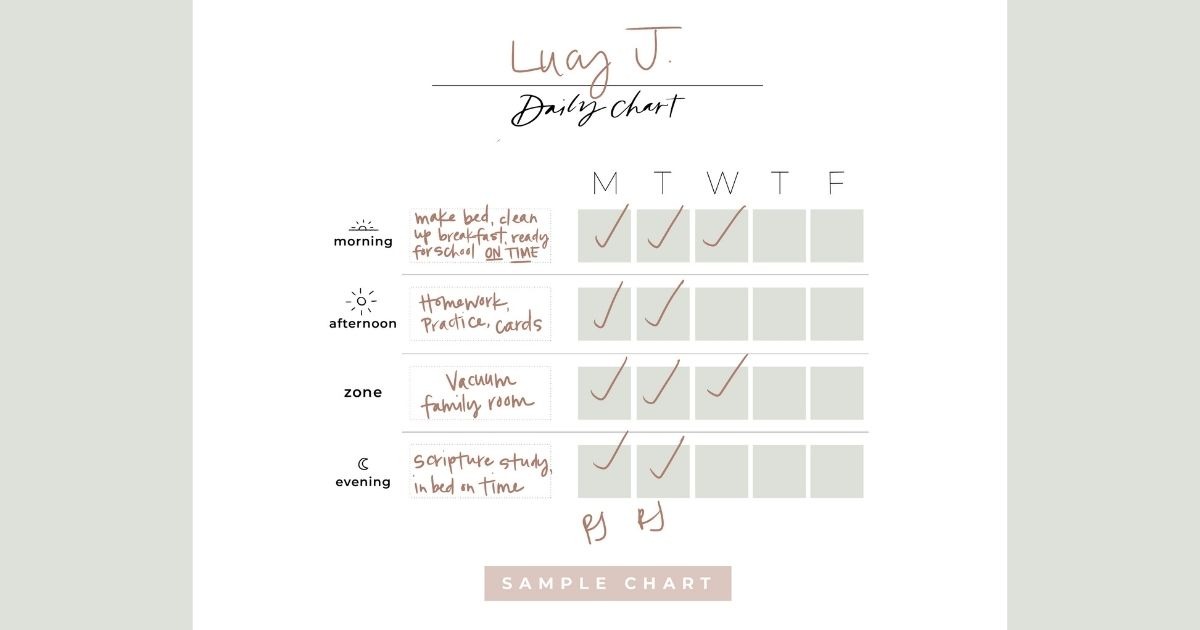A family economy is a work for pay system where children earn money, save, and learn accountability within the home. Watch my webinar, Teaching the Value of Work: The Family Economy where I teach how to implement this system.
What if I told you I could answer the following parenting concerns with just one system?
- How can I teach my child true gratitude?
- What do I do to get him/her self-motivated enough?
- Am I always going to have whining, needy kids at the grocery store?
Let me introduce you to my good friend, the family economy.
What is a Family Economy?
A family economy is a simple work and pay system.
The base idea is that you take the money you are already spending on your children (for clothes, toys, birthday gifts for friends and siblings, etc.) and reroute it through their choices (their responsibilities they can choose to complete).
The goal is to create a safe microcosm of the real world at home through lots of purposeful opportunities to earn, spend, save, and give that money.
In our home, that means our girls earn money for completing the following daily tasks:
- making their bed
- putting away breakfast dishes
- being ready for school on time
- homework
- piano practice
- zone (specific rotating chore)
- being ready for bed on time
I can already see your thought bubble forming.
“Why do I have to pay them for things they should already be doing?”
If this question comes to your mind, you are not alone! Parents, I invite you to change your mindset.
It is their job and responsibility to help family life run smoothly. So it is our job to pay them a small portion of the money that comes into the home and reroute everything through their choices and decisions. You would already be spending that money on them anyway but with this system, they work to earn it and then decide how to spend or save it.
This creates a sense of ownership for your child. They have true ownership over their family home, their lives, their possessions, and their time.
Why it is Better Than an Allowance
A family economy truly is the best of both worlds as it gives your kids real-life experience with earning and spending money, while also teaching values and strong character.
First, the family economy gives your children ample experiences with money from a young age: to earn, save, spend, and give.
The only way to learn about money is to have money. – Dave Ramsey
In the family economy, just like the real world, the amount of effort is directly related to the amount of reward.
As our children grow older, the amount of money they can earn each week increases, but so do their responsibilities and the items they are responsible to buy. For example, at age 8, they pay for half of their clothes and starting at age 12 they pay for everything (excluding underclothes and family-sponsored outings).
But even the money is not the biggest lesson here. The biggest lesson is what money allows our children to do. Money is only a vehicle for serving others and learning important values.
Second, putting them in charge of money allows them to learn honesty, generosity, kindness, self-management, and delayed gratification.
As they complete their daily tasks they are learning time management, household skills, and a strong work ethic.
I can’t even count the times my daughters have chosen to use their money to buy a special treat to cheer up a sibling or friend. This is only possible because of our family economic system.
But of all the values the family economy teaches, gratitude is my very favorite.
You will never have a child who is more grateful for new shoes as a birthday gift, a sibling buying them a Slurpee, or hand-me-downs from a neighbor than a child who knows the value of money and hard work.
How Does a Family Economy Work?
As a family, decide which tasks can be completed daily to contribute to the flow of family life (see my list above), and how much money can be earned each week.
Children are invited to get involved to whatever extent they want. The family economy works differently than an allowance because it directly connects your child’s efforts with a reward.
The family economy is a self-reinforcing system meaning that if they join in, they will earn the benefits of participating.
When we give our children choices, it moves them along the spectrum of motivation from external to internal.
They understand they can make choices that make them happy, and then they choose to make them more often. Our children learn positive association to good behavior and they learn all this in a low-risk environment.
The family economy is also optional. This means no nagging, forcing, or begging.
Want more detailed information about how the family economy is run in our home? See the follow-up post Everything You Want to Know (and More) About Our Family Economy.
Family Economy Charts
Here are 5 simple steps to using the daily charts as part of your family economy:
- Print a chart out for each child who will be doing the family economy. We’ve included different colored charts for families with multiple kids to help you differentiate between them. *PRO TIP* Laminate your chart! (Or put it in a page protector or cover the front side with packing tape – nothing fancy required here.) This will save you the headache of printing a new page every week.
- Fill out the chart by having your child write her/his name at the top and using the blank spaces in each row to record what the child’s responsibilities are. Make sure your child knows exactly what is required of him/her in order to check off a box!
- Then, hang the chart somewhere visible and easily accessible for both you and your child. Perhaps where there are markers and pens handy.
- Explain to your child that he/she is responsible for completing each task each day in order to get paid over the weekend. You will not be nagging or pushing. At the end of each day, you will initial just below the day’s squares, showing you saw that everything checked was actually completed.
- Begin! Give yourself and your child grace as you start and remember to be excited about it – your child will feed off your enthusiasm.
Want to learn more about the family economy? Be sure to read The Entitlement Trap by Richard and Linda Eyre. You can also listen to me talk about how the family economy works in our home here on Instagram and on my IGTV channel.
Daily Chart Printable
To help you begin your own version of a family economy I have created an amazing resource for you!
Our family economy bundle includes simple instructions for starting your own family economy as well as my favorite version of our daily charts. These charts can be used for your child to track his/her progress throughout the week. There are 5 options so pick the one that works best for your family or an individual child.
Good luck, have fun and remember, we are working together with our children for a better, happier future!
If you want more tools to be an intentional parent, you might also like these other free resources.
- Everything You Want to Know (and More) About Our Family Economy
- 5 Love Languages for Kids: A Simple Guide to Using Love Languages
- Why Quality Time Matters: A Busy Parent’s Guide to Connection
This article is based on the fabulous work of the Eyre Family. The Entitlement Trap, the premise of this idea, was originally written by Richard and Linda Eyre. (You can find more of their great work at ValuesParenting.com.)




How does the system change when your child has a part time job?
How long does your weekend payout take? That is where I fail. And if you don’t pay regularly, the entire process doesn’t work. How do I make payout easier?
How do other chores in the house factor in? I like your requirements for each day, but there are still other jobs that need to happen in our home.
I would love to know if this changes at all when kids are home for the summer. Do you have your kids do more to help around the house since they have more time (and let’s be honest–make more messes)? Also, since there is typically no homework during the summer.
What amount of money is reasonable? Boys under 12 years old. Thank you!
Hi Lindsey! What Ralphie suggests is that they can earn their age in dollars per week, so an 8-year-old can earn $8 a week. Check out her follow-up post for with more details about payday and how they ask their kids to divide that amount into saving and spending.